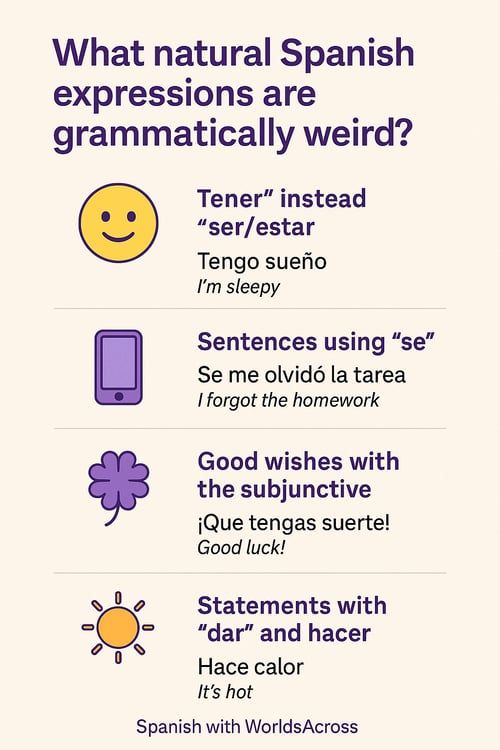What natural Spanish expressions are grammatically weird?
It is extremely common for new Spanish learners to be shocked by some irregular but natural expressions. In fact, thinking that some Spanish phrases are weird is almost a rite of passage!
For example, something as easy as “Tengo 20 años.”
At first, you’ll probably think, “What do you mean you have 20 years? Where do you have them? Don’t you mean you are 20 years old?”
If you want the explanation for this and other confusing idiomatic phrases, you’re in the right place. Trust me, you’re going to need them if you really want to sound natural.
So, let’s take a deep dive into the unusual side of Spanish grammar!

The culture shock of Spanish grammar
For native Spanish speakers, certain non-standard constructions feel completely normal. But for people learning the language, they can be a big surprise.
This is a completely understandable reaction, though! It’s natural to expect a new language to follow the grammar rules you know. Any deviation from the norm can feel surprising.
When learning a new language, our first impulse is to directly translate every new thing, right? And when the translation doesn’t make sense… The immediate reaction is “Oh. This is wrong!”
Even though these phrases are very common, they break the rules, they are grammar exceptions. This can overwhelm students who are just starting to understand Spanish grammar.
But these uncommon sentences are more important than you might think!
Why are these sentences important to learn?
This is the most important part of this discussion. Fortunately, the answer is quite easy. It’s all about learning real Spanish.
These are just some of the reasons why you need to understand these irregular but natural expressions in Spanish:
- Native speakers use them all the time. You need to know these phrases to be able to understand them.
- If you start to use them, your Spanish will sound more natural and authentic. Fluent speakers naturally use grammar exceptions.
- These are conversational structures. If you try to use literal translation, it’ll sound off, wrong, and not fluent at all.
- They can change your views on Spanish grammar. You’ll see it isn’t so scary and strict. Sometimes, it’s okay to break the rules!
Once you embrace the importance of these non-conventional sentences, you’re ready for the next step! Good job!
Now, let’s take a closer look at them.
Examples of irregular but natural expressions in Spanish
These are the most common cases you will encounter in your everyday life. I mean it! They really are so practical and useful even in the most casual conversations.
From feeling hungry and losing your phone, to good wishes and the dread subjunctive mood. ¡Veamos!
“Tener” instead of “ser/estar”
Some Spanish comments sound weird to English speakers for this reason. They use the verb “Tener”, which means “to have”. Instead of using the verbs “ser” or “estar”, which mean “to be”.
This takes us back to our original example: “Tengo 20 años.”
In Spanish, things like your age and certain feelings are things that you “have”, instead of things that you “are”.
Here are some examples:
- I am 20 years - Tengo 20 años
- I am hungry - Tengo hambre
- I am cold - Tengo frío
- I am sleepy - Tengo sueño
Sentences using “se”
These can be an unexpected challenge for new learners. You’ve probably heard the sentence “Se me olvidó”. That’s a clear example of a non-standard construction. You basically skip the subject of the sentence!
We call them “accidental ‘se’ constructions”. Like the name says, we use them to talk about accidents. But also about things that happened unintentionally. Or just to soften the blame, you know?
For example:
- Se me olvidó la tarea - I forgot the homework
- Se te cayó el teléfono - You dropped your phone
- Se le rompió el vaso - He broke the glass
- Se nos perdió el perro - We lost the dog
- Se te olvidaron las llaves - You forgot the keys
They can sound odd to English speakers, because the literal translation would be something like “The homework was forgotten to me.”
But if you can master these idiomatic phrases, you’ll sound much more natural than if you said “Yo olvidé el libro.” And hey, you’ll even take off some of the blame.
Good wishes with the subjunctive
The subjunctive is already a famous struggle for Spanish students. It doesn’t have to be, though! It’s okay to just learn some fixed expressions, even if they don’t seem to make much sense at first.
For example, the expression “Que tengas suerte”. That’s very common to hear from native speakers.
But, if you try to translate it literally to English, it would be something along the lines of “That you have luck”. Weird, right?
You just need to know it means something like “I hope you have luck” or “I wish you luck.”
See? It’s much nicer and easier if you accept it as one of Spanish’s fixed expressions.
You got this! If you can handle these few examples, you’ve already taken a big step into understanding "grammatically weird” Spanish.
Statements with “dar” and “hacer”
Here, you will find yet another group of conversational structures that will sound strange to English speakers.
Like, what do you mean something “gives” you fear? And hot weather “does” heat?
I know, I know, they can feel off. But you have to accept that they are not only okay, they are the norm in Spanish!
Here are a few examples:
- Esa película me da miedo - That movie scares me
- Hace calor - It’s hot
- Me da pena cantar - I feel embarrassed to sing
- Hace mucho frío - It’s very cold

How to understand and use these sentences
Naturally, this is the next step. Let me give you a few useful tips that you can try today to master these unusual idiomatic phrases in Spanish.
- Accept the “weirdness"
To be more precise: Accept that these non-standard constructions aren’t weird at all. They are part of the language. And just because they don’t follow your grammar expectations, it doesn’t mean they are wrong.
- Learn them as “fixed expressions”
Sometimes, it’s okay if you don’t understand the grammar yet! That takes time. It can wait.
It’s fine if you don’t understand why Spanish speakers say “Que tengas suerte”. If you know it means good luck, you can start using it too!
- Pay extra attention to native speakers.
This is, of course, good advice in general. But even more when we’re talking about understanding conversational structures. Native speakers will be your best example of when and how to break grammar rules!
Don’t try to understand these sentences too deeply. Just pay attention to when and how native speakers use them. Remember: it’s best to learn the full sentence, not word-for-word.
And of course, at the end of the day, just remember it’s all part of the process!
It’s normal to be confused at first. And it’s going to be perfectly fine if you make some mistakes at first. They are unusual sentences after all.
But now you have all the tools you need to master these irregular but natural expressions in Spanish. As soon as you start using them, you’ll see how your Spanish sounds much more natural and fluent!
So go ahead, give them a try! I hope you have fun with these new phrases.


